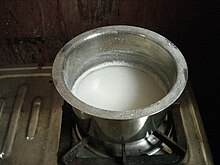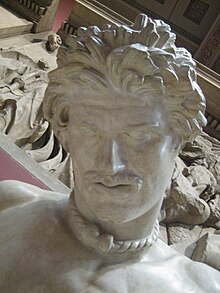Limewater

Limewater is the common name for a saturated aqueous solution of calcium hydroxide. Calcium hydroxide, Ca(OH)2, is sparsely soluble at room temperature in water (1.5 g/L at 25 °C[1]). "Pure" (i.e. less than or fully saturated) limewater is clear and colorless, with a slight earthy smell and an astringent/bitter taste. It is basic in nature with a pH of 12.4.
Limewater may be prepared by mixing calcium hydroxide (Ca(OH)2) with water and removing excess undissolved solute (e.g. by filtration). When excess calcium hydroxide is added (or when environmental conditions are altered, e.g. when its temperature is raised sufficiently), a milky solution results due to the homogeneous suspension of excess calcium hydroxide. This liquid has been known traditionally as milk of lime.
Chemistry[]
An experiment commonly used to demonstrate the interaction of CO2 and Ca(OH)2 is as follows.

Resultant carbon dioxide passed through limewater in the right tube, producing a milky solution due to precipitation of the insoluble suspension of calcium carbonate:
- Ca(OH)2(aq) + CO2(g) → CaCO3(s) + H2O(l)
If excess CO2 is added: the following reaction takes place:
- CaCO3(s) + H2O(l) + CO2(g) → Ca(HCO3)2(aq)
The milkiness disappears since calcium bicarbonate is water-soluble.
Applications[]
The above chemical properties are commonly used for testing the presence of carbon dioxide in gaseous samples in school laboratories, and refining of sugar in a process called carbonatation.
Industry[]
Waste gases from industries containing sulphur dioxide can be cleaned by bubbling through limewater, a process called sulfation, in which the toxic sulphur dioxide is trapped as a precipitate:
- Ca(OH)2(aq) + SO2(g) → CaSO3(s) + H2O(l)
Water treatment[]
Limewater is used in a process known as lime softening to reduce water hardness. It is also used as a neutralizing agent in municipal waste water treatment.
Arts[]
In buon fresco painting, limewater is used as the colour solvent to apply on fresh plaster. Historically, it is known as the paint whitewash.

Personal care and adornment[]
Treating one's hair with limewater causes it to stiffen and bleach, with the added benefit of killing any lice or mites living there. According to Diodorus Siculus, he described the Celtic people as such; "Their aspect is terrifying... They are very tall in stature, with rippling muscles under clear white skin. Their hair is blond, but not only naturally so: they bleach it, to this day, artificially, washing it in lime and combing it back from their foreheads. They look like wood-demons, their hair thick and shaggy like a horse's mane. Some of them are clean-shaven, but others – especially those of high rank, shave their cheeks but leave a moustache that covers the whole mouth...".[2][3]
Food preparation[]
Limewater is used in the preparation of maize for corn tortillas and other culinary purposes using a process known as nixtamalization. This unlocks proteins in the cornmeal, making it more nutritious for the consumer. Eating maize-based foods without nixtamalization or supplementation with legumes or meat leads to a nutritional deficiency known as pellagra.
Other uses[]
Limewater is widely used by marine aquarists as a primary supplement of calcium and alkalinity for reef aquariums. Corals of order Scleractinia build their endoskeletons from aragonite (a polymorph of calcium carbonate). When used for this purpose, limewater is usually referred to as Kalkwasser. It is also used in tanning and making parchment. The lime is used as a dehairing agent based on its alkaline properties.[4]
References[]
- ^ 'Solubility of Inorganic and Metalorganic Compounds – A Compilation of Solubility Data from the Periodical Literature', A. Seidell, W. F. Linke, Van Nostrand (Publisher), 1953[ISBN missing]
- ^ "Diodorus Siculus, Library of History | Exploring Celtic Civilizations".
- ^ "Diodorus Siculus – Book V, Chapter 28". penelope.uchicago.edu. Retrieved 2017-11-12.
- ^ The Nature and Making of Parchment by Ronald Reed[ISBN missing]
- Calcium compounds
- Hydroxides
- Chemical tests